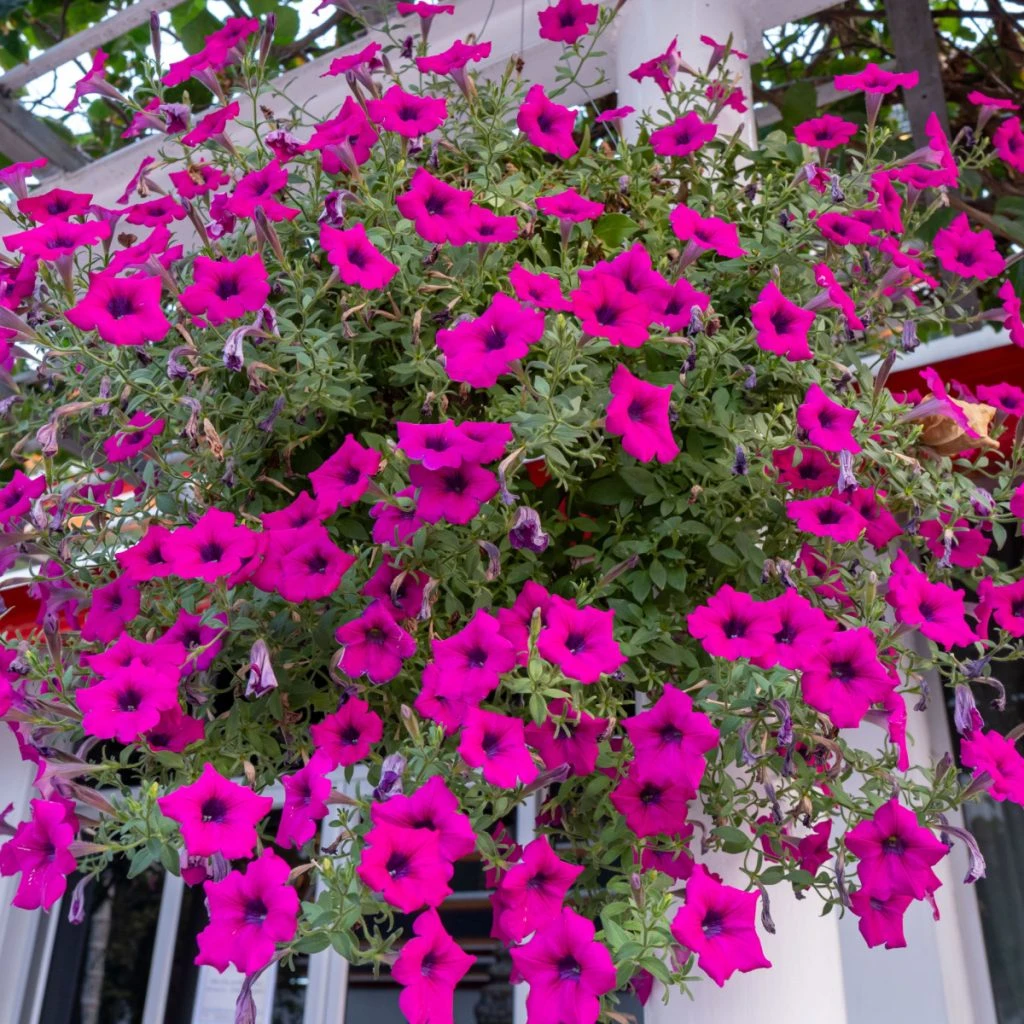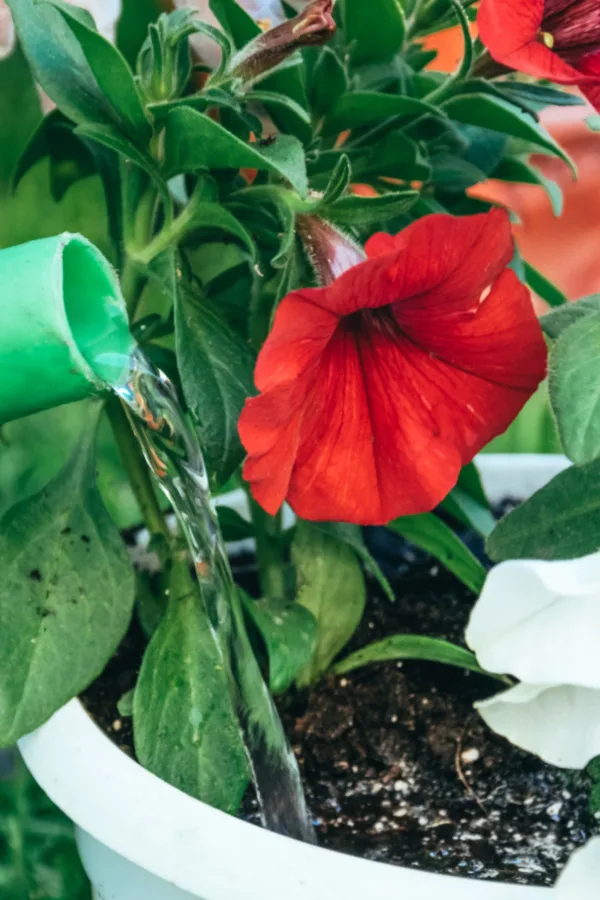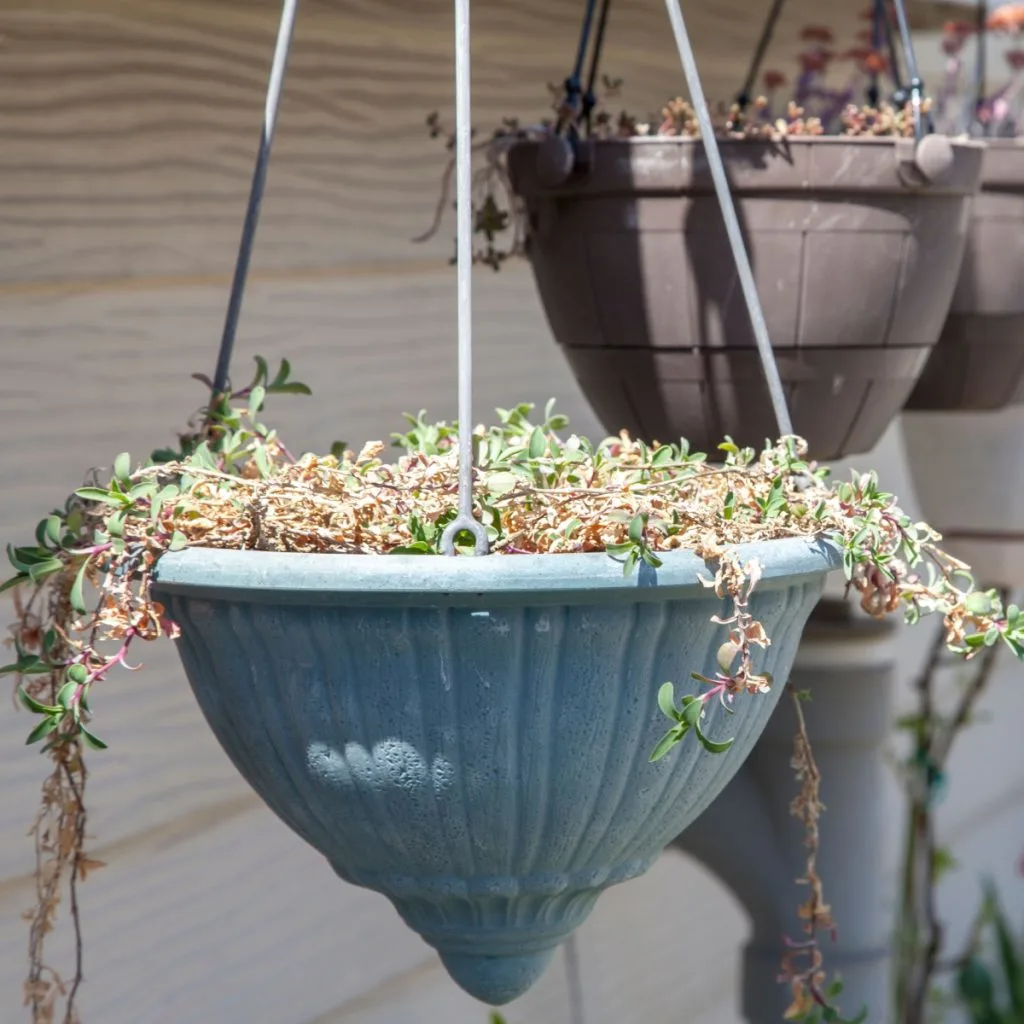Looking for a few simple secrets and tips to keep your new petunia baskets blooming big all spring and summer long?
There’s nothing quite like a lush, full petunia basket spilling over with bright, vibrant blooms. Whether they’re hanging on a porch, a patio, or out in the garden, they bring life and color anywhere they grow.
But as beautiful as they are, those same gorgeous petunia baskets that you purchased or planted in the spring can quickly fade away. By mid-summer, they can become an overgrown, bloom-less and lifeless plant. Especially if they’re not cared for the right way!

But here’s the good news – it doesn’t have to be that way! In fact, keeping your petunia baskets thriving and blooming strong through the entire growing season doesn’t have to be difficult at all. Armed with just a few simple tips, you can keep those flowers coming on strong from late spring all the way through to fall.
The best part – It only takes a little time and attention to make a big difference. But the key is you need to start maintaining them right from the start!
3 Simple Secrets To Keep Petunia Baskets Blooming Big
1. Fertilize Often – But At Half Strength
One of the most important keys to keeping your petunias looking their best is regular feeding. Petunias are heavy feeders, especially when grown in hanging baskets or containers. Unlike garden soil, containers don’t hold onto nutrients very long.
Rain and watering can quickly wash nutrients away, leaving the plants with very little to work with. But while it’s true that petunias need food to keep blooming, how and what you feed them with matters even more.

Over-fertilizing can cause problems just as quickly as not fertilizing at all. When petunias are given too much fertilizer – especially a fertilizer that’s high in nitrogen – they tend to grow more leaves and roots than flowers. The plant may look full and green, but the blooms can be few and far between.
That’s why the best way to fertilize petunias is to feed them more often, but with a much weaker solution. Instead of using a full-strength dose every couple of weeks, the best method is to use a half-strength mix of liquid fertilizer every 7 to 10 days.
This steady, gentle stream of nutrients gives the plant just enough to grow and bloom without overwhelming it or forcing it to produce too much foliage.
The Best Fertilizer To Keep Petunia Baskets Blooming
When choosing a fertilizer, look for one that’s formulated with blooming in mind. A fertilizer with a higher middle and end number (phosphorus and potassium) will do the trick. These two nutrients help support root health and flower production, rather than pushing out too much green growth.
Liquid fertilizers that are near a 10-20-20 or 10-30-25 blend work much better than an all-purpose blend. Affiliate Link: Jack’s Classic 10-30-20 Blossom Booster Water-Soluble Fertilizer.
Listen In Below To Our Podcast On How To Fertilize Hanging Baskets!
2. Deadhead Your Baskets Often
If there’s one chore that can instantly improve the look and performance of your petunia baskets, it’s deadheading. Simply put, deadheading is the process of removing old, spent blooms from the plant. It may seem like a small task, but the impact it has on blooming power is huge.
When petunias finish blooming, the flower begins to wither and fade. At that point, the plant starts putting energy into forming seeds where the flower used to be. That seed production takes a lot of energy . And that energy could be better spent to keep petunia baskets blooming instead!
By removing the old blooms before they have a chance to set seed, you stop the plant from wasting valuable resources. It’s nature’s way of ensuring the plant keeps trying to reproduce, and in turn, you get more and more flowers.
Deadheading petunias is a quick job, and it can easily be done every few days while you’re watering or checking on your plants. Just pinch or snip off the flower stem right below the bloom where it meets the plant. It’s important to remove the entire seed pod along with the bloom, not just the petals.

Some newer varieties of petunias are bred to be “self-cleaning,” meaning they drop their spent blooms naturally. While these types are lower maintenance, even they can benefit from occasional deadheading to keep the plant tidy and redirect energy to new flowers.
Keeping up with deadheading not only helps with more blooms, but it also helps the basket look fresh and full. For more on this topic, check out our article: The Best Way To Deadhead Petunias.
3. Use Larger Containers To Keep Petunia Baskets Blooming
Another big mistake gardeners make when growing petunias in baskets is using a container that’s simply too small. Small baskets might be easier to hang or handle, but they can create serious problems down the road. Especially when the plants begin to outgrow their space.
Petunias have large, vigorous root systems, especially when they’re growing full force through the heat of summer. When the roots don’t have enough room to grow, they quickly become root-bound.
When this occurs, the roots start circling the inside of the container, creating a tight, tangled mass that can’t take in nutrients or moisture properly. Once petunias become root-bound, they begin to struggle.

Bigger Is Best To Keep Petunia Baskets Blooming
To prevent this, start your petunias off right by planting them in large enough containers from the beginning. For hanging baskets, aim for containers that are at least 16 to 20 inches in diameter. Larger baskets not only give the roots more room, but they also hold more soil.
That extra soil helps retain moisture longer, gives the roots more nutrients to pull from, and helps regulate temperature around the root zone.
Also, be sure that your baskets have proper drainage. Too much water can be just as harmful as too little, so having a few drainage holes at the bottom of the basket allows extra water to escape and keeps the roots from sitting in soggy soil.
Finally, if you are planting your own baskets, don’t overcrowd the basket. It might be tempting to pack in lots of young petunia plants for an early full look, but as they grow, they’ll need more room. Two to three well-spaced petunias in a 16- to 20-inch basket is often plenty. They’ll fill out quickly and stay healthier than an overcrowded container.
Here is to keeping your petunia baskets blooming all spring and summer – and right into late fall!
Simple Garden Life
Follow Our Facebook Page For Even More Great Tips! Simple Garden Life Facebook Page
Simple Garden Life is a website dedicated to keeping gardening fun, simple and enjoyable! We publish two new articles each week along with a new garden podcast episode every two weeks. This article may contain affiliate links.
